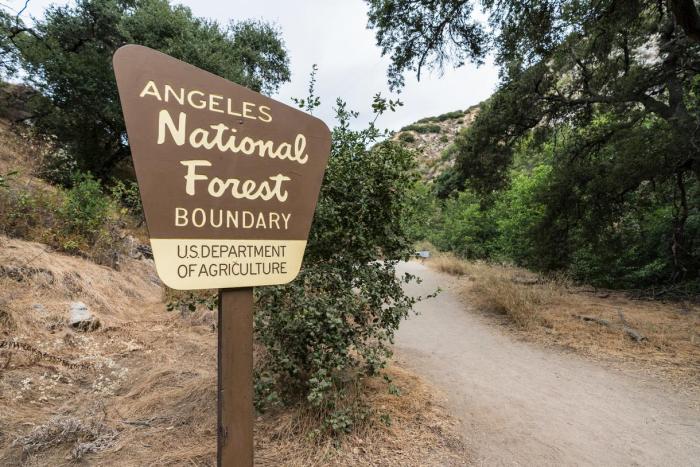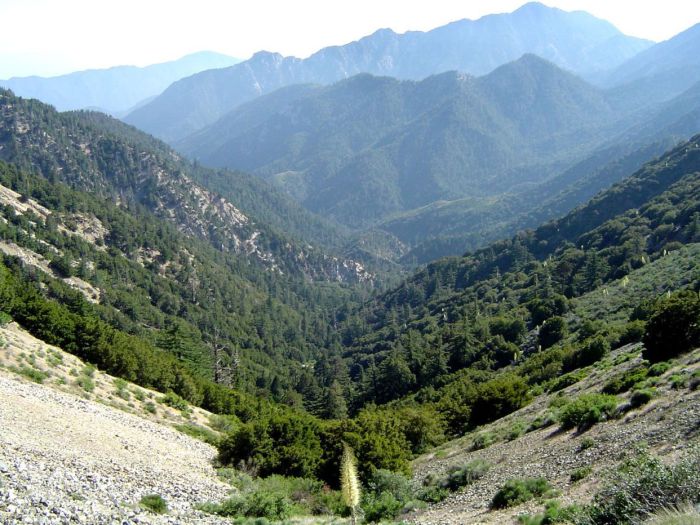Nestled in the heart of Southern California, Angeles National Forest is a sprawling wonderland that offers an unparalleled blend of outdoor adventure, ecological significance, and cultural heritage. Spanning over 650,000 acres, this majestic forest invites visitors to explore its diverse landscapes, abundant wildlife, and rich history.
From towering peaks to tranquil streams, Angeles National Forest is a haven for outdoor enthusiasts. Whether you seek the exhilaration of hiking through ancient oak woodlands or the serenity of casting a line in crystal-clear lakes, the forest provides a myriad of recreational opportunities.
Angeles National Forest Overview

Established in 1908, Angeles National Forest is a sprawling expanse of natural beauty and ecological significance located in Southern California. It is nestled amidst the San Gabriel, San Bernardino, and Santa Monica Mountains, covering over 656,000 acres of diverse landscapes.
The forest serves as a crucial watershed for the Los Angeles metropolitan area, providing clean water to millions of residents. Its vast network of canyons, peaks, and rivers supports a rich biodiversity, including numerous endangered and threatened species.
Geographic Location and Boundaries
Angeles National Forest encompasses a significant portion of Los Angeles County, stretching from the Santa Clarita Valley in the west to the San Bernardino Mountains in the east. It is bounded by the Mojave Desert to the north and the Pacific Ocean to the south.
Nestled in the San Gabriel Mountains, Angeles National Forest offers a plethora of recreational opportunities. However, for those seeking a deeper cultural immersion, venturing beyond its scenic trails leads to an array of best cultural festivals worldwide. From vibrant celebrations in neighboring cities to unique events held within the forest itself, Angeles National Forest serves as a gateway to a rich tapestry of cultural experiences.
Ecological Significance
The forest plays a vital role in maintaining the ecological balance of the region. Its diverse ecosystems provide habitat for a wide range of plant and animal species, including the California condor, the endangered mountain yellow-legged frog, and the threatened southern California steelhead trout.
The forest also acts as a natural buffer, protecting coastal communities from wildfires and floods. Its dense vegetation helps to trap sediment and pollutants, improving water quality and air quality in the surrounding areas.
Nestled amidst the breathtaking vistas of the Angeles National Forest, nature enthusiasts can immerse themselves in tranquility. However, for those seeking a touch of indulgence, luxury travel deals abound in the surrounding areas. From opulent resorts with panoramic views to exclusive guided tours of the forest’s hidden gems, discerning travelers can elevate their Angeles National Forest experience to new heights of luxury and adventure.
Recreation and Activities

Angeles National Forest offers a diverse range of recreational opportunities for visitors of all ages and abilities. From hiking and camping to fishing and horseback riding, there’s something for everyone to enjoy.
Popular Trails and Destinations, Angeles national forest
The forest boasts an extensive network of trails, catering to hikers of all levels. Some of the most popular trails include:
- Mount Baldy Trail: A challenging but rewarding hike to the highest peak in the San Gabriel Mountains, offering panoramic views.
- Eaton Canyon Trail: A scenic trail featuring a waterfall, lush vegetation, and a seasonal swimming hole.
- Bridge to Nowhere Trail: A historic trail leading to a massive stone bridge that was never completed.
Camping Facilities
Angeles National Forest offers a variety of camping options, from primitive campsites to developed campgrounds. Developed campgrounds provide amenities such as picnic tables, fire rings, and restrooms. Popular campgrounds include:
- Chilao Campground: A large campground with over 100 campsites, located near the Chilao Visitor Center.
- Buckhorn Campground: A smaller campground with 25 campsites, situated along the West Fork of the San Gabriel River.
- Pine Flat Campground: A primitive campground with 12 campsites, offering solitude and access to the Pacific Crest Trail.
Reservations are recommended for all developed campgrounds, especially during peak season.
The Angeles National Forest, a vast expanse of natural beauty, offers a respite from the hustle and bustle of city life. Its towering trees, crystal-clear streams, and panoramic vistas beckon hikers, campers, and nature enthusiasts alike. Just like the vibrant coastal town of Albufeira in Portugal, with its golden beaches, charming streets, and lively nightlife, the Angeles National Forest offers a rich tapestry of experiences that will rejuvenate the soul and create lasting memories.
Flora and Fauna
Angeles National Forest is renowned for its extraordinary biodiversity, showcasing a vibrant tapestry of plant and animal life. From towering trees to delicate wildflowers and a diverse array of wildlife, the forest teems with life.
Flora
The forest’s flora is a captivating spectacle, with over 1,200 plant species thriving within its diverse ecosystems. Towering conifers, including ponderosa pines, sugar pines, and Douglas firs, form majestic canopies that filter sunlight, creating a dappled mosaic on the forest floor.
- Shrubs, such as manzanita, chaparral, and scrub oak, provide shelter and sustenance for a multitude of creatures.
- Wildflowers, including poppies, lupines, and Indian paintbrush, add vibrant hues to the landscape, especially during the springtime.
Fauna
Angeles National Forest is a haven for wildlife, supporting a rich and diverse array of species. Mammals, such as black bears, bobcats, coyotes, and deer, roam the forest’s rugged terrain.
- Over 250 bird species grace the skies, including majestic golden eagles, playful hummingbirds, and migratory warblers.
- Reptiles and amphibians also find refuge within the forest, including snakes, lizards, salamanders, and frogs.
Conservation Efforts
Recognizing the ecological significance of Angeles National Forest, concerted efforts are underway to protect and preserve its biodiversity. Conservation measures include habitat restoration, invasive species management, and wildlife monitoring programs.
- Reforestation projects aim to restore native plant communities, ensuring the long-term health of the forest ecosystem.
- Invasive species control programs combat the spread of non-native plants that threaten the forest’s delicate balance.
- Wildlife monitoring initiatives provide valuable data on population trends, allowing for informed conservation strategies.
Management and Sustainability

The Angeles National Forest is managed by the United States Forest Service (USFS), an agency within the United States Department of Agriculture (USDA). The USFS is responsible for managing the forest’s resources, including its timber, water, wildlife, and recreation opportunities. The USFS also works to protect the forest from fire, pests, and other threats.
The USFS has implemented a number of sustainable practices to preserve the forest’s resources. These practices include:
Fire Prevention
The USFS works to prevent fires in the Angeles National Forest by educating the public about fire safety, maintaining fire roads and trails, and conducting prescribed burns. Prescribed burns are controlled fires that are used to reduce the amount of flammable vegetation in the forest and to create a more fire-resistant landscape.
Watershed Protection
The Angeles National Forest is home to a number of watersheds that provide water for Southern California. The USFS works to protect these watersheds by managing the forest’s vegetation, reducing erosion, and improving water quality.
Wildlife Management
The Angeles National Forest is home to a variety of wildlife, including deer, bear, mountain lions, and birds. The USFS works to manage the forest’s wildlife populations by protecting their habitat, providing food and water, and controlling predators.
Cultural and Historical Significance

The Angeles National Forest is a treasure trove of cultural and historical significance. From its ancient Native American roots to its role in early European exploration, the forest has played a pivotal role in shaping the history of Southern California.
Native American Presence
For thousands of years, the Angeles National Forest was home to various Native American tribes, including the Tongva, Serrano, and Cahuilla. These tribes relied on the forest’s resources for sustenance and shelter, and they developed a deep spiritual connection to the land.
- The Tongva, also known as the “People of the Earth,” inhabited the coastal areas of the forest and were skilled fishermen and gatherers.
- The Serrano, or “People of the Mountains,” lived in the higher elevations and were known for their hunting and pottery-making.
- The Cahuilla, or “People of the Desert,” resided in the eastern portion of the forest and were adept at farming and basket weaving.
Early European Exploration
In the 18th century, European explorers began venturing into the Angeles National Forest. The first recorded expedition was led by Gaspar de Portolá in 1769, who named the area “Los Angeles” after the angels who guided him to safety.
- In 1826, Jedediah Smith became the first American to explore the forest, opening up the region for settlement.
- In the 1840s, the forest became a popular destination for gold seekers during the California Gold Rush.
- In the late 19th century, the forest was used for logging and grazing, leading to the establishment of the Angeles National Forest in 1908.
Historical Landmarks and Sites
The Angeles National Forest is home to numerous historical landmarks and sites that reflect its rich cultural and historical past.
- The Mission San Gabriel Arcángel, founded in 1771, is the oldest surviving building in Los Angeles County.
- The San Bernardino Mountains are home to numerous Native American rock art sites, providing a glimpse into the lives of the region’s earliest inhabitants.
- The Agua Mansa Pioneer Cemetery contains the graves of many early settlers and pioneers of the forest.
Preservation and Interpretation
Efforts are ongoing to preserve and interpret the cultural heritage of the Angeles National Forest. The U.S. Forest Service, in collaboration with local tribes and historical organizations, works to protect historical sites, conduct research, and educate the public about the forest’s rich cultural past.
- The Angeles National Forest Cultural Heritage Program provides grants and technical assistance to organizations working to preserve and interpret the forest’s cultural resources.
- The Angeles National Forest History Association hosts events and publishes materials to promote the history of the forest.
- The San Gabriel Mountains National Monument includes many historically significant sites, such as the San Gabriel Mission and the San Bernardino Mountains rock art sites.
Closing Summary
As the sun dips below the horizon, casting a warm glow over the forest, Angeles National Forest transforms into a realm of tranquility and wonder. The chorus of birdsong fades into a gentle hum, and the air fills with the scent of wildflowers. In this moment of solitude, one can truly appreciate the beauty and majesty of this natural treasure.
Angeles National Forest stands as a testament to the interconnectedness of nature and culture. Its towering trees have witnessed centuries of human history, from the presence of Native American tribes to the arrival of European settlers. Today, the forest continues to serve as a source of inspiration, recreation, and environmental stewardship for generations to come.
Query Resolution
What is the best time to visit Angeles National Forest?
Spring and fall offer the most pleasant weather for outdoor activities, with moderate temperatures and fewer crowds.
Are there any fees associated with visiting Angeles National Forest?
Yes, there are fees for certain activities such as camping and parking. Check the Forest Service website for specific details.
Can I bring my dog to Angeles National Forest?
Yes, dogs are allowed on leash in most areas of the forest, but there are some designated off-leash areas as well.
What are some popular hiking trails in Angeles National Forest?
The Mount Wilson Trail, Eaton Canyon Trail, and Fern Dell Trail are among the most popular hiking trails in the forest.